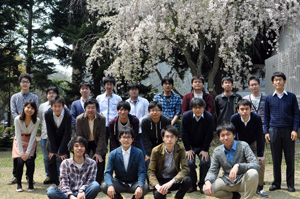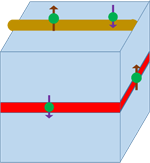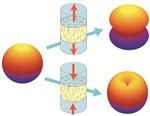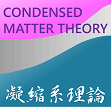When microscopic elements obeying quantum mechanics such as electrons, atoms, and molecules aggregate by a macroscopic number and interact with each other, completely new physical phenomena, markedly different from the property of each element, occur. Superconductivity, superfluidity, Bose-Einstein condensation, magnetism, and metal-insulator transition are typical examples. The Condensed Matter Theory Group aims to understand the various physical phenomena of such systems from the viewpoint of the quantum many-body theory. In order to understand these many-body problems, knowledge of the basic laws governing individual elements is not enough and element reductionism does not apply. In that sense, even today condensed matter physics is full of the possibility of discovering attractive new phenomena. We aim to discover new universal laws behind these many-body phenomena and to construct theories to describe them. For these purposes, we employ a wide range of approaches including analytical methods such as the field theory as well as numerical simulation using computers.

Various quantum condensation phases of highly correlated electron systems
|
In solids in which electrons move with strong correlation, interesting properties, such as a large effective mass of electrons, which can be several thousand times larger than the bare mass in the so-called heavy electron systems, anisotropic superconductivity and Mott transition, appear. Also, in systems where localized spins interact with each other, competition of various ordered phases is observed. Furthermore, it is an interesting question how the nonuniformity of the system affects the formation of such ordered phases. We investigate the nature of systems in which various degrees of freedom such as electron spin, orbitals and lattice vibration are intertwined, using renormalization group methods, dynamic mean field theory and other methods.
|  |
Phase transitions in low-dimensional systems with strong quantum fluctuation effects
|
In organic materials and transition metal oxides, the electronic structure often has such extreme anisotropy that it is effectively one- or two-dimensional. Experiments that artificially control the dimensionality of crystals have progressed rapidly. Also, ultracold atomic gases have been confined to low dimensions. The effect of quantum fluctuation appears particularly strongly in one- and two-dimensional systems. Strong analytical methods such as conformal field theory and Bethe ansatz solution can be used in one dimensional systems. Numerically, the behavior of various many-body systems is almost exactly calculated by methods such as the density matrix renormalization group. We are working to elucidate the diverse behaviors of many-body systems in low dimension from microscopic points of view.
|  |
Superfluid ^4 He and ^3 He as systems with remarkable quantum effects
|
Helium is the only element that does not become solid down to absolute zero at normal pressure. Bosonic ^4 He and fermionic ^3 He become superfluids at low temperature. For ^3 He, we have theoretically predicted that it has a new Fermi superfluid phase, realized not in bulk but by adsorption to a solid surface or introduction into a nanoscale porous medium. Regarding ^4 He, which is a Bose system, we are focusing on the universal aspects such as the critical fluctuation accompanying the phase transition and the effect of disorder of the system.
|  |
Quantum Condensed Phase and Dynamics of Cold Atom Systems
|
Experiments have been conducted to control the atomic potential and interatomic interactions for neutral atoms cooled to ultracold temperatures in vacuum. The Bose-Einstein condensate with various internal degrees of freedom and the BCS-BEC crossover of fermionic systems have been realized, and the introduction of various periodic lattices like crystals by optical standing waves has also been realized. These systems are attracting attention as quantum simulators that emulate parts of complicated quantum many-body phenomena of solid system with parameters widely controlled. We are conducting research to elucidate and predict novel quantum condensed phases in various optical lattice systems and quantum dynamics realized as these systems are externally driven.
|  |
Topological phases of quantum multiple body systems
|
The quantum Hall effect and quantized vortices in superconductors and superfluids are topologically characterized. In recent years, new phenomena such as the quantum spin Hall effect are found one after another on the surface or interface of insulators having topologically non-trivial electronic states, and superconductors deeply related to such topological insulators have been also discovered. We aim to predict new topological phases that realize various novel transport phenomena, focusing on strongly correlated electron systems and systems coupled to strong light.
|  |
Superconducting phase under magnetic field
|
Since superconductors are often put to practical use under uniform magnetic fields, research on superconductivity under magnetic field is important. Various novel superconducting states such as FFLO superconductivity, vortex glass, etc. have been found so far in the situation where superconductivity is partially broken due to generation of quantum vortices by uniform magnetic field and Pauli paramagnetism. With the advent of various superconducting materials, various aspects such as phase transition with a strong critical fluctuation, effect of Pauli paramagnetism enhanced by electronic correlation, phenomena related to the physics of ultracold atomic systems, and so on have been found. We are pursuing comprehensive research on such interesting phenomena.
|  |

